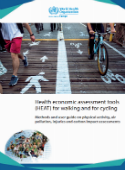Health economic assessment tool (HEAT) for walking and for cycling. Methods and user guide on physical activity, air pollution, injuries and carbon impact assessments (2017)

Download
2017, ix + 73 pages
ISBN 978 92 890 5278 8
By Sonja Kahlmeier, Thomas Götschi, Nick Cavill, Alberto Castro Fernandez, Christian Brand, David Rojas Rueda, James Woodcock, Paul Kelly, Christoph Lieb, Pekka Oja, Charlie Foster, Harry Rutter and Francesca Racioppi
This publication is only available online.
The promotion of cycling and walking for everyday physical activity not only promotes health but can also have positive effects on the environment.
This publication summarizes the tools and guidance developed to facilitate this shift: the methodology for the economic assessment of transport infrastructure and policies in relation to the health effects of walking and cycling; systematic reviews of the economic and health literature; and guidance on applying the health economic assessment tools and the principles underlying it.
It has been updated to consider the health effects of road crashes and air pollution and the effects on carbon emissions. The tool can be used for several types of assessment, for example:
- assessing current (or past) levels of cycling or walking, such as showing the value of cycling or walking in a city or country;
- assessing changes over time, such as comparing before-and-after situations or scenario A versus scenario B (such as with or without measures taken); and
- evaluating new or existing projects, including calculating benefit–cost ratios. HEAT can be used as a stand-alone tool or to provide input into more comprehensive economic appraisal exercises or prospective health impact assessment.
This methodology and user guide will be of key interest to professionals at both national and local levels: transport planners, traffic engineers, and special interest groups working on transport, walking, cycling or the environment, as well as health economists, physical activity experts and health promotion experts.
The 2017 edition of this publication was supported in part by the project Physical Activity through Sustainable Transport Approaches (PASTA), which is funded by the European Union’s Seventh Framework Programme under EC-GA No. 602624-2 (FP7-HEALTH-2013-INNOVATION-1). The generous support of the Austrian Federal Ministry for Agriculture, Forestry, Environment and Water Management, the German Federal Ministry for the Environment, Nature Conservation, Building and Nuclear Safety, the Swiss Federal Office of Public Health, the Swedish Expertise Fund and a consortium of donors from the United Kingdom under the leadership of Natural England that supported previous editions is also gratefully acknowledged.



